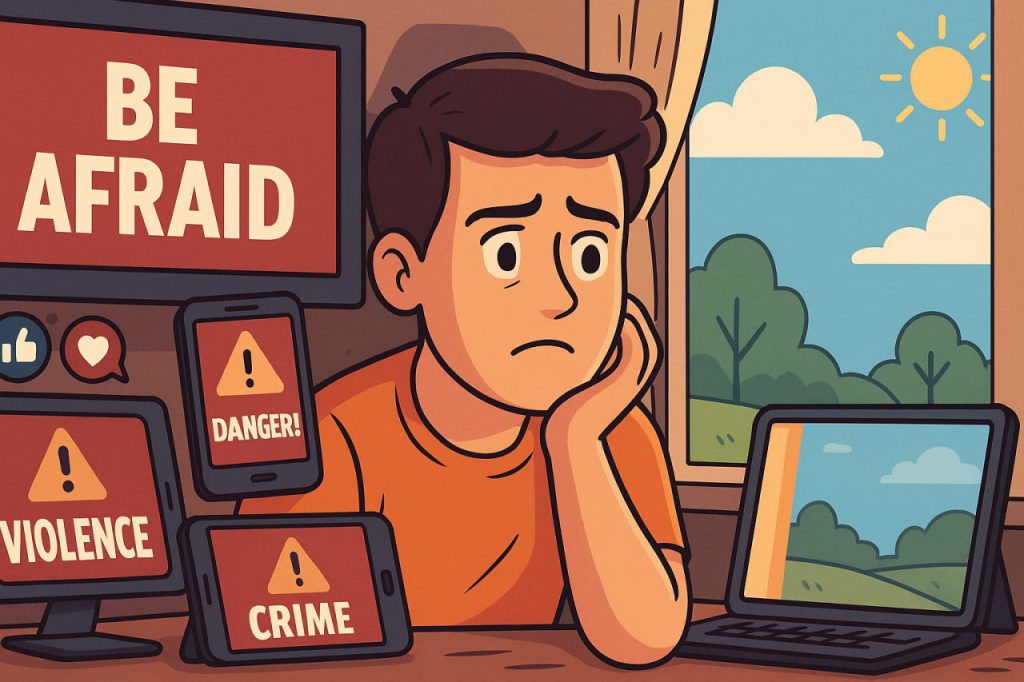In the age of nonstop information, the world can often seem darker and more threatening than it truly is. This distorted perception is known as Mean World Syndrome, a psychological phenomenon where continuous exposure to violent or negative media content makes people believe that the world is more dangerous than it actually is. The term was coined by communications scholar George Gerbner in the 1970s, who discovered that heavy television viewers consistently overestimated crime rates and perceived strangers as potential threats. Today, in the era of social media, the effects of this syndrome are stronger—and more widespread—than ever before.
The Origins of Mean World Syndrome
Dr. Gerbner’s research began during the rise of television, a time when mass media first became central to public consciousness. Through his Cultivation Theory, he demonstrated that repeated exposure to certain themes—such as violence, fear, and conflict—shapes how people interpret reality. Viewers who watched large amounts of crime shows or sensational news coverage tended to believe that danger lurked everywhere, regardless of actual statistics. The media’s tendency to emphasize rare but dramatic events cultivated a perception that the world was mean, hostile, and unpredictable.
How Media Reinforces Fear
Modern media, including social platforms and streaming services, amplifies the same psychological mechanisms Gerbner warned about. News outlets prioritize stories that evoke fear or outrage because such content captures attention and drives engagement. Algorithms on social media platforms magnify emotionally charged posts, creating echo chambers where fear-based content circulates endlessly. Psychologists note that this exposure triggers the amygdala, the brain’s emotional center, heightening anxiety and making individuals more suspicious of others. Over time, these effects can lead to chronic stress, social withdrawal, and mistrust.
The Psychological Effects
The consequences of Mean World Syndrome go beyond simple pessimism. Individuals who believe the world is unsafe often display symptoms similar to hypervigilance—constantly scanning for threats and interpreting ambiguous situations as dangerous. Studies show correlations between media-induced fear and increased levels of cortisol, the body’s stress hormone. Prolonged exposure can lead to anxiety disorders, depression, and sleep disturbances. Sociologically, it fosters social polarization, as groups retreat into defensive ideologies, believing they must protect themselves from a hostile world.
Mean World Syndrome in the Digital Age
In today’s digital ecosystem, Mean World Syndrome has evolved. While television once shaped public fears, social media now personalizes them. Algorithms feed users stories that reinforce their existing anxieties—whether about politics, crime, or global crises. Viral videos of isolated violent acts can create the illusion of widespread chaos, even when crime rates are declining. Constant connectivity ensures that fear never fades; a single click can open a flood of tragedies from across the globe, transforming distant dangers into intimate psychological stressors.
Expert Perspectives
According to Dr. Mary Alvord, a clinical psychologist specializing in media psychology, “Our brains are not wired to process global suffering 24/7. The illusion of danger everywhere makes us anxious, even in safe environments.” Media scholars such as Dr. Michael Morgan, Gerbner’s longtime collaborator, argue that the key issue is not just media violence, but the imbalance of representation: stories of fear vastly outnumber stories of kindness and resilience. This imbalance, they suggest, warps the collective understanding of humanity itself.
Breaking the Cycle
The first step in combating Mean World Syndrome is media literacy—the ability to analyze and question how information is presented. Recognizing bias, verifying sources, and limiting exposure to negative content can significantly reduce fear-based thinking. Experts recommend setting boundaries for news consumption and diversifying media habits by including educational, artistic, or solution-oriented content. Offline experiences—spending time in nature, volunteering, or interacting face-to-face—help restore perspective and trust in others.
The Role of Journalists and Media Creators
Media professionals hold significant ethical responsibility in shaping perception. Balanced reporting that includes stories of progress, innovation, and human compassion can counter the negativity bias. Some news outlets have adopted constructive journalism, focusing on solutions rather than just problems. This approach helps audiences remain informed without feeling hopeless. As media continues to evolve, integrating empathy and factual depth into storytelling is essential for protecting public mental health.
Sociological Implications
On a larger scale, Mean World Syndrome influences political and cultural attitudes. Populations that feel unsafe are more likely to support strict laws, surveillance, or isolationist policies. Fear-based narratives can polarize societies and erode trust in institutions. Sociologists argue that understanding this syndrome is crucial for preserving democracy and social harmony in an era where emotional manipulation is a powerful political tool.
Interesting Facts
- The term Mean World Syndrome originated from George Gerbner’s television research in the 1970s.
- Studies show that heavy TV viewers overestimate crime rates by up to 200%.
- Social media algorithms can double exposure to violent or negative content within one week of regular use.
- Despite global declines in violence, 71% of people believe the world is getting more dangerous.
- Constructive journalism programs have been shown to lower stress and increase civic engagement.
Glossary
- Mean World Syndrome – A psychological condition where people perceive the world as more dangerous due to negative media exposure.
- Cultivation Theory – The idea that long-term media exposure shapes viewers’ perceptions of reality.
- Amygdala – The part of the brain that processes emotions like fear and anxiety.
- Hypervigilance – A heightened state of constant alertness and sensitivity to potential threats.
- Echo Chamber – An online environment where users only encounter opinions that reinforce their existing beliefs.
- Negativity Bias – The human tendency to focus more on negative than positive information.
- Constructive Journalism – A media approach that emphasizes solutions and progress rather than fear and conflict.
- Cortisol – A hormone released during stress that affects mood and physical health.
- Media Literacy – The skill of critically evaluating and interpreting media messages.
- Emotional Contagion – The phenomenon of sharing and mirroring emotions seen in others, often amplified online.


